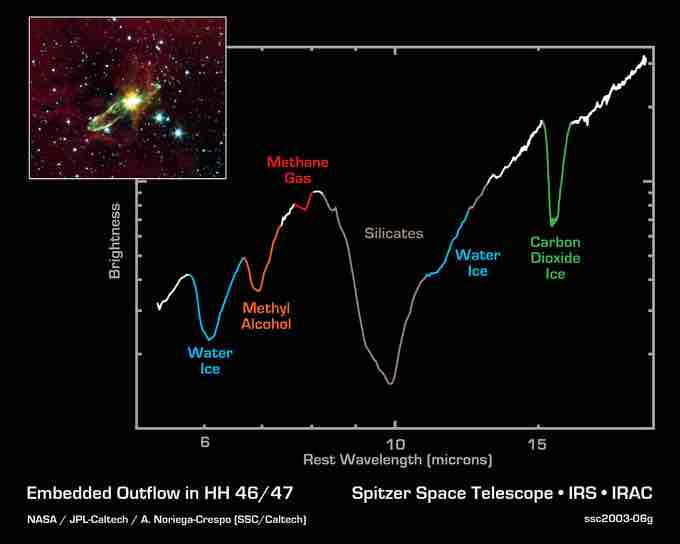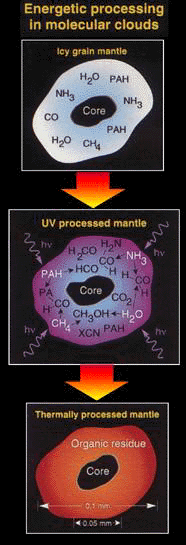There is substantial understanding of how inorganic molecules can give rise to somewhat simple building blocks of life in the process known as abiogenesis. For example, nucleic and amino acids can be made in laboratory simulations of the early earth, but how these acids polymerized to make the long chain needed for life is unknown. On the other hand, once a simple protocell capable of replication forms, upon encountering its specific antigen, evolution then takes it course and the myriad ways in which cells try to survive can be understood. However, the question of how simple organic molecules form a protocell is largely unanswered.
There are a few problems consistently seen in most scenarios of abiogenesis. One such problem involves polymerization. The thermodynamic equilibrium of amino acid versus peptides is in the direction of separate amino acids. However, a force that drives polymerization is missing. The random association of single amino acids into one short protein string of 100 amino acids without some enzymatic help could take an incredible amount of time, longer than the age of the earth. Several mechanisms for such polymerization have been suggested, but the resolution of this problem may well be in the properties of polyphosphates. Polyphosphates are formed by polymerization of ordinary monophosphate ions PO4−3. Polyphosphates cause polymerization of amino acids into peptides. They are also the logical precursors in the synthesis of key biochemical compounds such as ATP. A key issue seems to be that calcium reacts with soluble phosphate to form insoluble calcium phosphate (apatite), so some plausible mechanism must be found to keep calcium ions from causing precipitation of phosphate.
Further, experiments that show how simple organic molecules can form (like the Miller-Urey experiment) depend on the assumption that the early earth was a reducing environment, having little oxygen. However, current scientific consensus describes the primitive atmosphere as either a weakly-reducing or neutral. Such an atmosphere would diminish both the amount and variety of amino acids that could be produced.
One further problem confronting many abiogenesis models is homochirality. Homochirality is the term used to describe all building blocks in living organisms having the same "handedness" (amino acids being left-handed, nucleic acid sugars (ribose and deoxyribose) being right-handed, and chiral phosphoglycerides). Some process in chemical evolution must account for the origin of this phenomenon. Chiral molecules can be synthesized, but in the absence of a chiral source or a chiral catalyst, they are formed in a 50/50 mixture of both enantiomer.
There are many models that are being used to explain these problems and others; one that is quite intriquing is the idea that the early earth was actually bombarded by extraterrestrial organic molecules. It should be clear the term extraterrestial in these abiogensis models are not referring to little green men, but rather complex organic molecules, of which the abiogenesis occurred in the more favourable conditions for such reactions in space. For instance, the environment in space is strongly reducing (ie no oxygen), and it has been suggested that meteorites introduced the phosphorus species to earth, which explains the need of monophosphate. Homochirality may also have started in space, as the studies of the amino acids on a meteorite showed L-alanine to be more than twice as frequent as its D form, and L-glutamic acid was more than 3 times prevalent than its D counterpart. While the idea of extraterrestrial abiogenesis once seemed far-fetched, the presence of organic molecules on meteorites (and recently in stars themselves) adds credence to this exciting possibility .

Organic molecules detected in space
NASA's Spitzer Space Telescope has lifted the cosmic veil to see an otherwise hidden newborn star, while detecting the presence of water and carbon dioxide ices, as well as organic molecules. The Spitzer image (inset) was obtained with the infrared array camera. The primary image shows a spectrum obtained with Spitzer's infrared spectrograph instrument, stretching from wavelengths of 5.5 microns to 20 microns. Spectra are graphical representations of a celestial object's unique blend of light. Characteristic patterns, or fingerprints, within the spectra allow astronomers to identify the object's chemical composition.

Organic biogenesis
A scheme depicting how organic molecules might be synthesized in space.